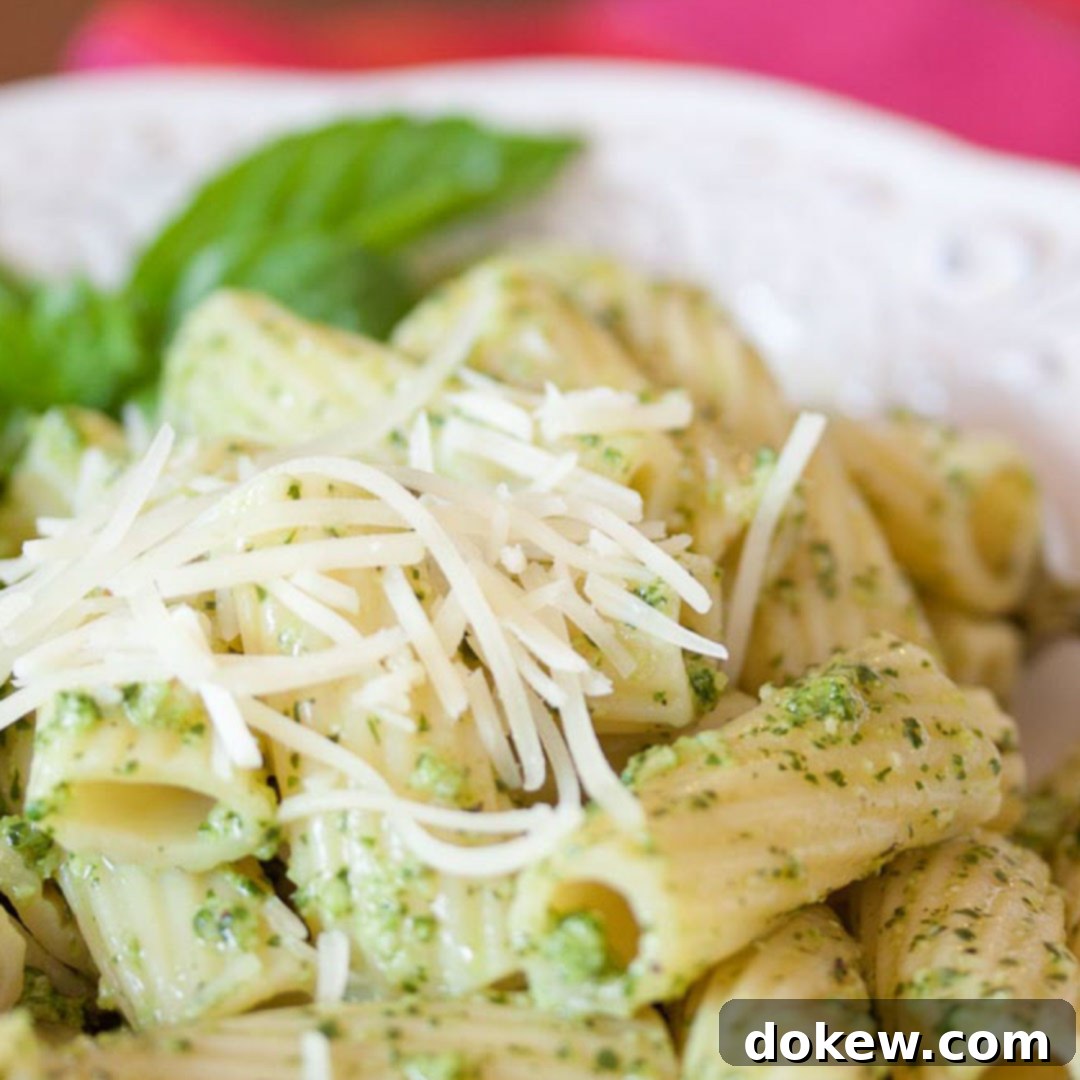Easy Homemade Pesto Pasta: A Quick & Fresh Weeknight Meal
Craving a flavorful, satisfying meal that comes together faster than takeout? Look no further than this incredible homemade pesto pasta! It’s the ultimate quick stovetop solution, delivering vibrant, fresh flavors right to your dinner table. Forget bland store-bought sauces; making your own pesto is surprisingly simple and can be whipped up in the time it takes for your pasta to boil. This recipe is a testament to delicious simplicity, perfect for those busy weeknights when you want something wholesome and utterly delicious without spending hours in the kitchen.
This article will guide you through crafting the perfect homemade pesto from scratch and combining it with your favorite pasta for a meal that truly shines. We’ll cover everything from selecting the freshest ingredients to clever tips for making your pesto extra special, ensuring a delightful culinary experience every time. Get ready to elevate your weeknight dinners with this effortlessly elegant dish!
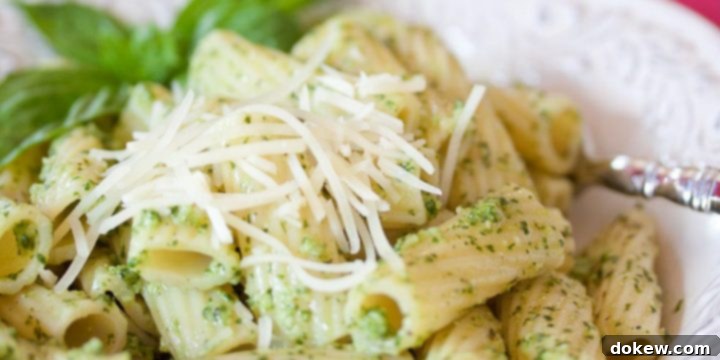
Why Homemade Pesto is Always Best
While convenience often calls for jarred pesto, nothing compares to the taste and aroma of a fresh, homemade batch. The difference is truly astounding. Store-bought versions often contain preservatives, excess salt, and sometimes even artificial flavors that dull the bright, herbaceous notes that are the hallmark of good pesto. When you make it yourself, you control every ingredient, ensuring a superior flavor profile and a sauce free from unwanted additives. Plus, the process itself is incredibly rewarding and only takes a few minutes using a food processor.
A fresh pesto elevates your pasta dish from good to extraordinary. The vibrant green color, the intoxicating scent of basil and garlic, and the rich, nutty undertones create a sensory experience that commercial products simply can’t replicate. It’s also a fantastic way to utilize an abundance of fresh basil from your garden or farmer’s market, transforming simple ingredients into a gourmet sauce.
The Heart of the Meal: Crafting Perfect Pesto
The beauty of pesto lies in its simplicity and the quality of its core ingredients. Each component plays a crucial role in creating that iconic, balanced flavor. Here’s a closer look at what makes homemade pesto so special:
Essential Pesto Ingredients: A Deep Dive
- Fresh Basil Leaves: This is non-negotiable for authentic pesto. Use bright green, unwilted leaves. Sweet basil is the most common and ideal choice, offering a slightly sweet and peppery aroma. Some purists even blanch their basil briefly before blending to preserve its vibrant green color, though it’s often unnecessary for immediate consumption.
- Parmesan Cheese: Opt for freshly grated Parmesan (Parmigiano-Reggiano) for the best flavor. Its salty, umami notes are essential for balancing the richness of the oil and the freshness of the basil. Pecorino Romano is a fantastic alternative or addition if you prefer a sharper, saltier kick.
- Extra Virgin Olive Oil: The quality of your olive oil significantly impacts the final taste. Choose a good quality extra virgin olive oil with a fruity, slightly peppery flavor. It binds the ingredients and adds a silky texture to the sauce. Avoid light olive oils, as they lack the robust flavor needed for pesto.
- Pine Nuts: These tiny nuts contribute a subtle buttery flavor and help create a creamy texture. For an intensified flavor, lightly toast your pine nuts in a dry pan over low heat until fragrant and slightly golden before adding them to the food processor. If pine nuts are expensive or hard to find, walnuts or almonds can be excellent substitutes, offering a slightly different but equally delicious nutty profile.
- Fresh Garlic Cloves: Garlic adds a pungent, aromatic kick. Adjust the amount to your liking – three cloves provide a noticeable but not overpowering flavor. Always use fresh garlic; dried garlic powder won’t give you the same vibrant taste.
Pesto Making Tips for Success
- Don’t Over-Process: While you want a smooth paste, over-processing can heat the basil, dulling its flavor and color. Pulse the ingredients in bursts.
- Add Oil Slowly: Drizzle the olive oil in a slow, steady stream while the food processor is running. This emulsifies the oil and helps create a creamy, cohesive sauce.
- Adjust Consistency: If your pesto is too thick, add a little more olive oil or even a tablespoon or two of the pasta cooking water (which contains starch and helps the sauce cling to the pasta).
- Season to Taste: While Parmesan cheese provides saltiness, taste your pesto before mixing with pasta and add salt and freshly ground black pepper as needed.
Choosing Your Pasta for Pesto Perfection
While this recipe specifically calls for rigatoni, pesto is incredibly versatile and pairs well with many pasta shapes. Rigatoni, with its wide, ridged tubes, is excellent for catching and holding the luscious pesto sauce, ensuring every bite is packed with flavor. Other fantastic options include:
- Spaghetti or Linguine: Classic long strands that are perfect for coating evenly.
- Penne or Fusilli: Shorter, shaped pastas that also do a great job of scooping up the sauce.
- Farfalle (Bow Ties): A fun shape that adds visual appeal and texture.
No matter which pasta you choose, always cook it al dente – firm to the bite. This ensures the pasta retains its texture and doesn’t become mushy when tossed with the pesto.
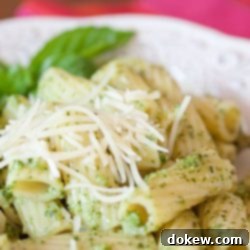
Pasta with Homemade Pesto
Mary Ann
Add to Shopping List
⌚
10 mins
15 mins
25 mins
🍴
Main Dish
Italian, Vegetarian
👤
8 servings
395
Ingredients
Pasta & Garnish
- 16 oz rigatoni
- ½ cup Parmesan cheese, for garnish
Pesto
- 2 cups fresh basil leaves
- ¼ cup Parmesan cheese
- ½ cup olive oil
- 3 tablespoons pine nuts
- 3 cloves garlic
Prevent your screen from going dark
Instructions
Boil the pasta
-
Prepare 16 oz rigatoni according to package directions.
Make the pesto
-
While the pasta is cooking, make the pesto.
-
Flatten 3 cloves garlic with the side of a knife and coarsely chop.
-
Place 2 cups fresh basil leaves into a food processor and process until well chopped.
-
Add a third of the 3 tablespoons pine nuts and ⅓ of the chopped garlic and blend again.
-
Add about a third of the ¼ cup Parmesan cheese and blend slowly while adding about a third of the ½ cup olive oil.
-
Stop to scrape the sides of the food processor, pushing the contents toward the bottom. Process until a smooth, thin paste is formed.
-
Repeat the process twice more with the remaining pesto ingredients until all pesto ingredients are used.
Combine, garnish, and serve
-
Add homemade pesto to prepared rigatoni and toss to coat.
-
Garnish with ½ cup Parmesan cheese and serve.
Nutrition per serving
Carbohydrates: 44 g
Protein: 12 g
Fat: 19 g
Sodium: 154 mg
Fiber: 2 g
Sugar: 2 g
Share on Facebook
Pin this Recipe
Serving Suggestions and Delicious Variations
This homemade pesto pasta is fantastic on its own, but it also serves as a wonderful canvas for adding other ingredients to create an even more satisfying meal. Here are some ideas to inspire your culinary creativity:
- Add Protein: Grill some chicken breast, pan-sear shrimp, or flake in some canned tuna for a more filling dish. Roasted chickpeas also make a great vegetarian protein addition.
- Vegetable Boost: Toss in cherry tomatoes (halved), roasted bell peppers, sautéed zucchini, or blanched green beans for extra nutrients and texture. Sun-dried tomatoes also add a lovely concentrated flavor.
- Freshness Factor: A squeeze of fresh lemon juice or a sprinkle of lemon zest brightens up the flavors beautifully.
- Make it Creamy: For a richer sauce, stir in a tablespoon or two of heavy cream or a dollop of ricotta cheese right before serving.
- Spice It Up: A pinch of red pepper flakes can add a subtle heat if you enjoy a little kick.
- Vegan Option: To make this recipe entirely vegan, substitute the Parmesan cheese with nutritional yeast, which provides a cheesy, umami flavor.
Serve your pesto pasta with a simple side salad and a loaf of crusty bread to sop up every last drop of that delicious sauce. It’s a meal that feels special yet is incredibly easy to achieve.
Storage Tips for Leftovers and Meal Prep
If you happen to have any leftover pesto or pasta, proper storage ensures you can enjoy the fresh flavors again. Homemade pesto can be stored in an airtight container in the refrigerator for up to a week. A key tip to prevent the basil from oxidizing and turning brown is to pour a thin layer of olive oil over the surface of the pesto before sealing the container. This creates a barrier that keeps the air out.
For longer storage, pesto freezes exceptionally well. Portion it into ice cube trays, freeze until solid, then transfer the pesto cubes to a freezer-safe bag or container. This way, you can easily pop out a few cubes whenever you need a quick burst of fresh flavor for future meals. Frozen pesto can last for several months.
Leftover pesto pasta should be stored in an airtight container in the refrigerator and consumed within 2-3 days. When reheating, you might want to add a splash of olive oil or a tablespoon of water to help loosen the sauce and bring back its creamy texture.
Related Recipe:
Pin this recipe for later:
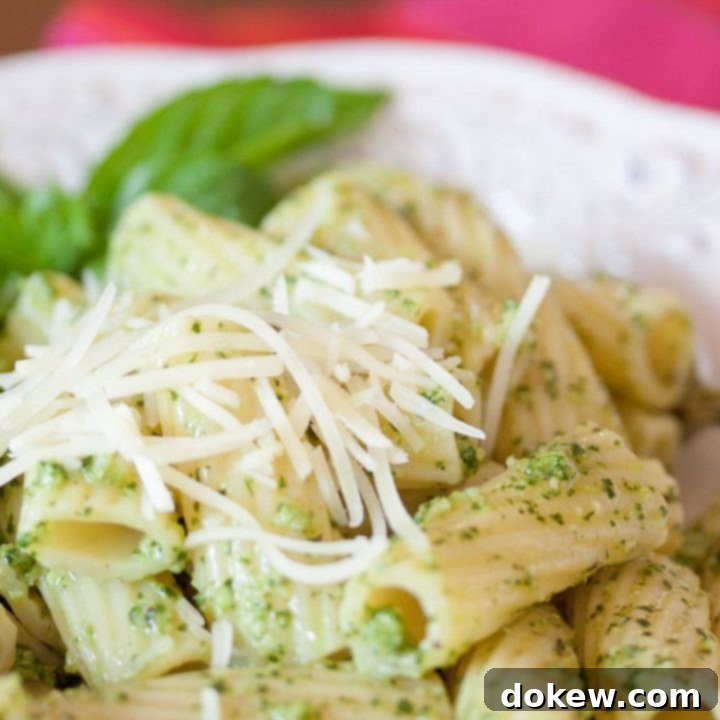
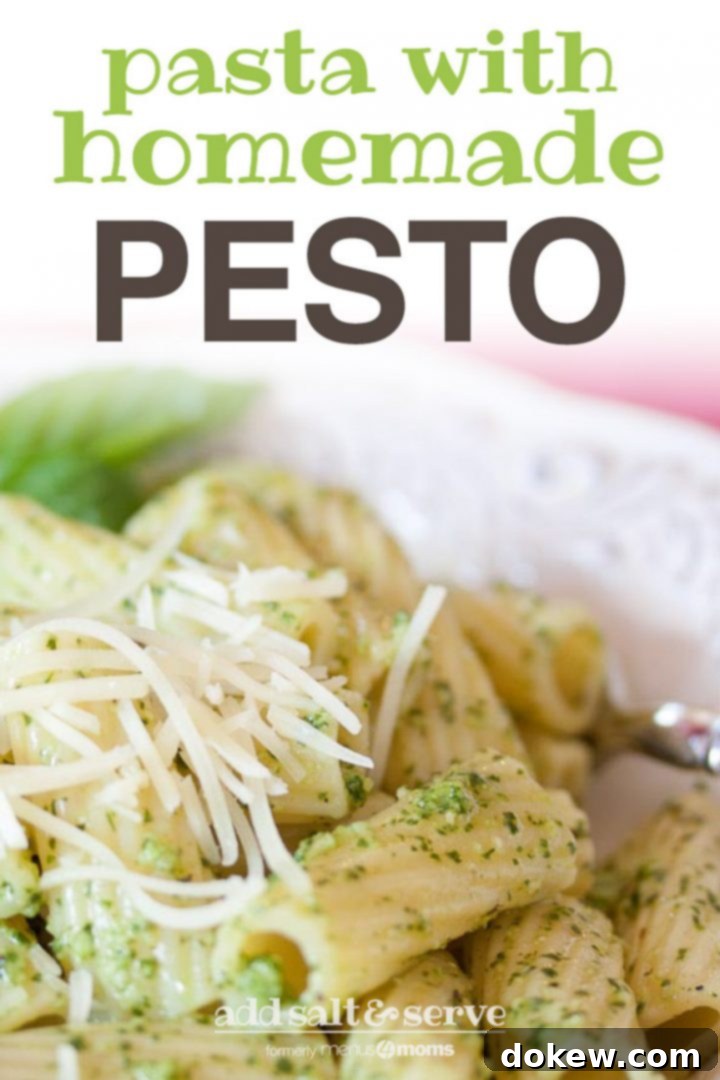
Conclusion
There you have it – a truly simple yet incredibly satisfying recipe for pasta with homemade pesto. This dish proves that healthy, flavorful meals don’t require hours of effort or a long list of exotic ingredients. With just a handful of fresh components and a few minutes of blending, you can create a culinary masterpiece that will impress your family and friends. The bright, fresh flavors of basil, garlic, and Parmesan, combined with the comforting embrace of perfectly cooked pasta, make this a dish you’ll want to add to your regular rotation.
So, the next time you’re looking for a quick, delicious, and fresh meal, remember this homemade pesto pasta. It’s not just food; it’s a celebration of simple, wholesome ingredients transformed into something truly special. Enjoy the process, savor the flavors, and delight in the knowledge that you’ve created something wonderful from scratch!
